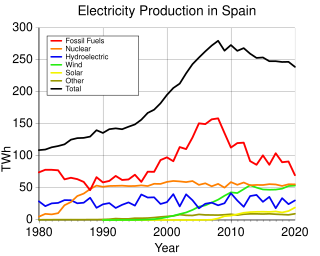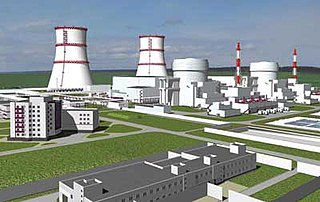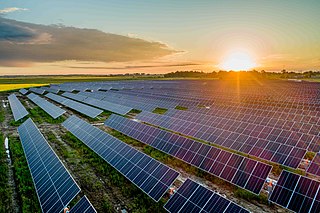Related Research Articles

The RBMK is a class of graphite-moderated nuclear power reactor designed and built by the Soviet Union. The name refers to its design where, instead of a large steel pressure vessel surrounding the entire core, the core is surrounded by a cylindrical annular steel tank inside a concrete vault and each fuel assembly is enclosed in an individual 8 cm (inner) diameter pipe. The channels also contain the coolant, and are surrounded by graphite.

Dry cask storage is a method of storing high-level radioactive waste, such as spent nuclear fuel that has already been cooled in the spent fuel pool for at least one year and often as much as ten years. Casks are typically steel cylinders that are either welded or bolted closed. The fuel rods inside are surrounded by inert gas. Ideally, the steel cylinder provides leak-tight containment of the spent fuel. Each cylinder is surrounded by additional steel, concrete, or other material to provide radiation shielding to workers and members of the public.

The Chernobyl Nuclear Power Plant is a nuclear power plant undergoing decommissioning. ChNPP is located near the abandoned city of Pripyat in northern Ukraine, 16.5 kilometers (10 mi) northwest of the city of Chernobyl, 16 kilometers (10 mi) from the Belarus–Ukraine border, and about 100 kilometers (62 mi) north of Kyiv. The plant was cooled by an engineered pond, fed by the Pripyat River about 5 kilometers (3 mi) northwest from its juncture with the Dnieper.

The Ignalina Nuclear Power Plant is a decommissioned two-unit RBMK-1500 nuclear power station in Visaginas Municipality, Lithuania. It was named after the nearby city of Ignalina. Due to the plant's similarities to the infamous Chernobyl Nuclear Power Plant in both reactor design and lack of a robust containment building, Lithuania agreed to close the plant as part of its accession agreement to the European Union. Unit 1 was closed in December 2004; Unit 2, which counted for 25% of Lithuania's electricity generating capacity and supplied about 70% of Lithuania's electrical demand, was closed on December 31, 2009. Proposals have been made to construct a new nuclear power plant at the site, but no such plan has yet come to fruition.
The electricity sector in Sweden has three operational nuclear power plants with 6 operational nuclear reactors, which produce about 29.8% of the country's electricity. The nation's largest power station, Forsmark Nuclear Power Plant, has three reactors producing 3.3 GW and 14% of Sweden's electricity.

Since the mid 1980s, the largest source of electricity in France has been nuclear power, with a generation of 379.5 TWh in 2019 and a total electricity production of 537.7 TWh. In 2018, the nuclear share was 71.67%, the highest percentage in the world.
Nuclear decommissioning is the process leading to the irreversible complete or partial closure of a nuclear facility, usually a nuclear reactor, with the ultimate aim at termination of the operating licence. The process usually runs according to a decommissioning plan, including the whole or partial dismantling and decontamination of the facility, ideally resulting in restoration of the environment up to greenfield status. The decommissioning plan is fulfilled when the approved end state of the facility has been reached.

Leningrad Nuclear Power Plant ) is a nuclear power plant located in the town of Sosnovy Bor in Russia's Leningrad Oblast, on the southern shore of the Gulf of Finland, some 70 kilometres (43 mi) to the west of the city centre of Saint Petersburg.

The Czech Republic operates two nuclear power plants: Temelín and Dukovany. As of 2019 the government intends to increase the share of nuclear electricity production from 30 % to 58 %. To this end, a new reactor is to be constructed at the Dukovany site, which will replace older units by 2035. New capacities are also expected to be added at the Temelín site.

Nuclear power in Switzerland is generated by three nuclear power plants, with a total of four operational reactors (see list below). Nuclear power has contributed a steady fraction of around forty percent to the Swiss electricity production since 1985. In 2022, it produced 23 terawatt-hours (TWh) of electricity, and accounted for 37% of the nation's gross electricity generation of 62 TWh, while 55% was produced by hydroelectric plants and 8% came from conventional thermal power stations and non-hydro renewable energy sources.

Spain has five active nuclear power plants with seven reactors producing 21% of the country's electricity as of 2013.

Visaginas Nuclear Power Plant was a planned nuclear power plant project in Lithuania. It was proposed to be built at the site of the closed Ignalina Nuclear Power Plant, which was shut down on 31 December 2009 in accordance with Lithuania's accession agreement to the European Union. The two reactors of the Ignalina plant are currently undergoing a decommissioning process.
Nuclear power in the European Union accounted for approximately 26% of total electricity production in 2019 and nearly half of low-carbon energy production across the EU.

The Kaliningrad Nuclear Power Plant (also referred as Baltic Nuclear Power Plant (NPP) or Baltiiskaya NPP, Russian: Калининградская атомная электростанция; Калининградская АЭС [] or Балтийская АЭС []) is a nuclear power plant under construction 13 kilometres (8.1 mi) south-east of Neman, in Kaliningrad Oblast, Russia. It is seen as a counter-project to the (later scrapped) plan to build the Visaginas nuclear power plant in Lithuania and is considered not only as an energy, but also as a geopolitical project. Originally intending to commission the reactors in 2016 and 2018, construction was temporarily stopped in June 2013 for the project to be redesigned for lower power output after neighbouring countries showed no interest in importing its electricity. However, the downgrade was later discarded. No export partners materialised as of 2021 and the project remains in stand-by.

The nuclear power debate is a long-running controversy about the risks and benefits of using nuclear reactors to generate electricity for civilian purposes. The debate about nuclear power peaked during the 1970s and 1980s, as more and more reactors were built and came online, and "reached an intensity unprecedented in the history of technology controversies" in some countries. In the 2010s, with growing public awareness about climate change and the critical role that carbon dioxide and methane emissions plays in causing the heating of the Earth's atmosphere, there was a resurgence in the intensity of the nuclear power debate.
National nuclear energy policy is a national policy concerning some or all aspects of nuclear energy, such as mining for nuclear fuel, extraction and processing of nuclear fuel from the ore, generating electricity by nuclear power, enriching and storing spent nuclear fuel and nuclear fuel reprocessing. Nuclear energy policies often include the regulation of energy use and standards relating to the nuclear fuel cycle.
Slovakia has five operational nuclear reactors, with a combined net power capacity of 2,308 MWe, with a sixth coming on line shortly.

Poland currently operates a single research reactor, Maria. It has no operational nuclear reactors for power production, but is to start construction of a plant with three Westinghouse AP1000 reactors in 2026, and is also intending to build small modular reactors.
NUKEM Technologies GmbH is a nuclear engineering and consulting company managing radioactive waste and spent fuel and decommissioning of nuclear facilities. The company is located in Alzenau, Germany. It was established in 2006 as a subsidiary of Nukem Energy. On 14 December 2009, Nukem Technologies was sold to Russian Atomstroyexport for €23.5 million.

Lithuania is a net energy importer. In 2019 Lithuania used around 11.4 TWh of electricity after producing just 3.6 TWh.
References
- 1 2 3 “Nuclear Power in Lithuania.” World Nuclear Association. February 2008. < "Nuclear Power in Lithuania | Lithuanian Nuclear Energy". Archived from the original on 2011-03-19. Retrieved 2011-03-16.>
- ↑ "Nuclear Power Plant Project in Lithuania is Feasible. Press release". Lietuvos Energija. 2006-10-25. Archived from the original on 2011-07-22. Retrieved 2007-07-13.
- ↑ "Visaginas Nuclear Power Plant". Ministry of Energy of the Republic of Lithuania. Archived from the original on 18 February 2018. Retrieved 17 February 2018.
- ↑ "Lithuania's ex-minister: Visaginas NPP plant project dead". The Baltic Course. 13 April 2016. Retrieved 17 February 2018.